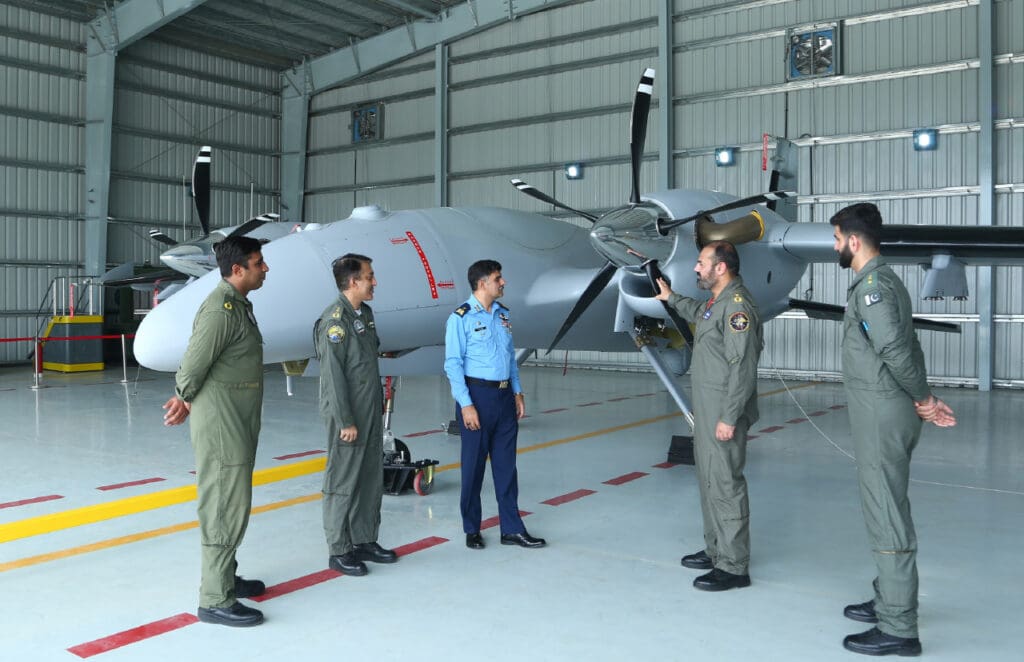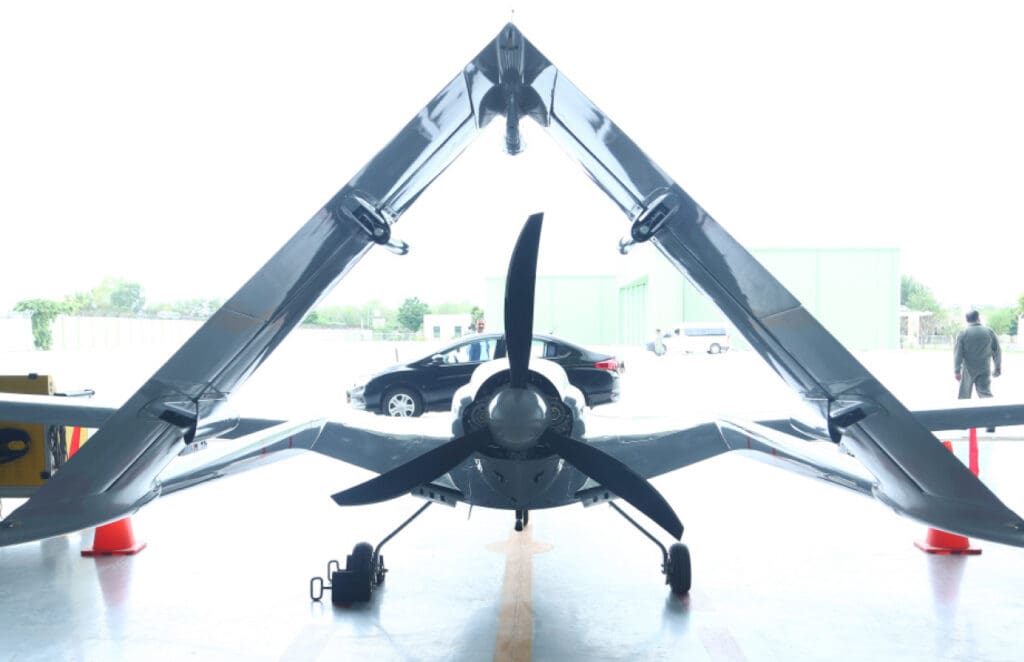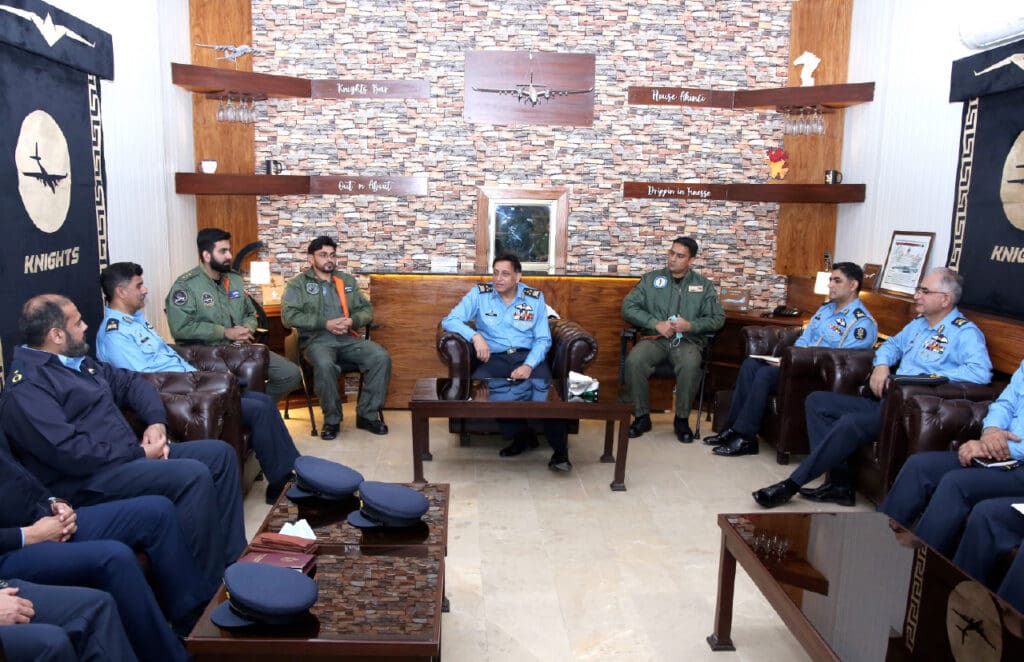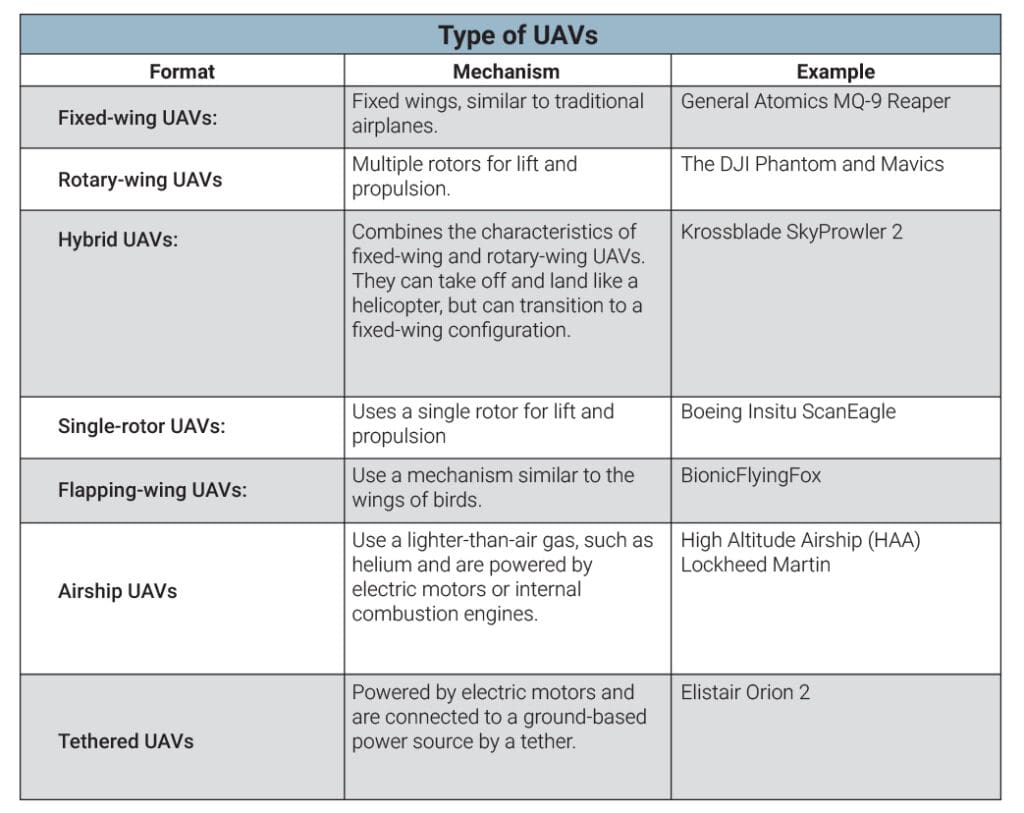The Pakistan Air Force has made significant strides in enhancing its Unmanned Aerial Vehicle (UAV) capabilities in recent years. With the development and acquisition of various state-of-the-art UAVs, PAF has bolstered its intelligence, surveillance, and reconnaissance (ISR) capabilities. These UAVs provide real-time data and situational awareness, making them invaluable for border security, counterterrorism operations, and monitoring remote areas. Additionally, the PAF’s UAV program has the potential to further expand and innovate, contributing to Pakistan’s defence and security needs while also exploring opportunities for export and collaboration with other nations in the ever-evolving field of unmanned aerial systems.
Armed drones are in high demand worldwide, thanks to their numerous strategic, technical, and economic advantages over manned aircraft. Their operational benefits include safeguarding military personnel, as drones can be remotely operated far away from the conflict zone. Additionally, these unmanned aerial vehicles (UAVs) excel at conducting prolonged surveillance missions over target locations. Moreover, armed drones offer exceptional responsiveness, with their missiles traveling at supersonic speeds to strike targets within seconds of being launched.

The economic appeal of drones is also evident, as they prove more cost-effective than other alternatives. A standard Predator drone costs just $4.5 million, a fraction of the price of an F-35 at $159 million, an F-22 at $377 million, or a B-2 at nearly $2 billion. Notably, the training of drone operators is also far more budget-friendly, with expenses amounting to only a tenth of those required to train traditional combat pilots. This financial advantage led a 2009 U.S. Air Force report to declare unmanned drones as “the wisest use of tax dollars.” This sentiment has reverberated beyond the United States, as major Western aerospace companies have invested more in the development of new UAVs/Drones as well as unmanned combat aircraft.
History:
The importance of unmanned aerial vehicles (UAVs) in the modern battle space is widely recognized in our times. Pakistan is no exception. The advent of UAVs in Pakistan can be traced back to the 1970s when the country began exploring the potential of unmanned aerial technology. The first step towards developing an indigenous UAV started in the late 1980s and continued throughout the 1990s. These small endeavours, although not having big budgets or widespread support, persevered for years owing to the efforts of the dedicated pioneers behind them.
Just after the world celebrated the end of the second millennium, PAF leaped forward into a similar transformative phase. Under the patronage of JSHQs the then CAS Air Chief Marshal Musaf Ali Mir highlighted the importance of drones technology that would propel the military into a new era. He enlightened the participants about the potential of UAVs. A man of a few but imperative words, his views always carried weight. His predictions and demands were backed by officials from other services. Specifically, the proposal revolved around the integration of four dedicated UAV flights. Presidential approval was also sought for the establishment of four cutting-edge Unmanned Aerial Vehicle (UAV) Strategic Squadrons. All present listened and the reasons given for the induction of UAVs on an official level made all the sense in the world. In the end, the Air Chief Marshal Mushaf Ali Mir along with his colleagues were able to secure approvals.
As soon as PAF received approvals, the planning phase started at full throttle. The top brass got together to create a roadmap for the integration of UAVs into PAF. Officially titled ‘Project Vision’, the endeavour was initiated under the leadership of late Air Commodore Shigri. One of the first inductees into Project Vision was Wing Commander Shahid Salim (Retd). He describes the earliest days of the program as seen from the eyes of a young officer.

“I still remember, it was the start of April 2003. I was in Peshawar at the time. I was called in and informed that I was to join the UAV Squadron. I felt a wave of excitement. It was obvious that we were going to be a part of something big. Initially, it was just me and Sqn Ldr Masood who were chosen. For all administrative purposes, we were with EW Ops and our assignment was with Project Vision, headed by Shigri Sahib. We moved to Islamabad. Masood would pick me up early in the morning and we’d go to E9 Park. The first time we saw the bird we were supposed to master was really something. Its name was Senior Cadet. It may not seem like much now but back then, it was state-of-the-art tech for us. It could fly at a speed of 100kph, staying in the air for more than 20 minutes at a time. That’s pretty much where the advanced tech ended, though. Our days with Senior Cadet usually compromised of standing in the park, under the shade of the trees, trying to get a grip on the spry UAV. We really did not have much in the way of infrastructure in the beginning. But then, I started bringing in chairs from my house and Masood would get something to eat. After we had mastered the Senior Cadet, we were given the Half Scale Trainer, or HST, as we called it. HST was much more advanced than the Senior Cadet. For the first time, we could see the real potential of UAVs in the battlefield.” Narrated Wg Cdr Shahid Saleem.
Focused on honing the crucial take-off and landing skills, HST employed a command receiver-based avionics system. With a length of 9.4 ft and a wingspan of 11.7 ft, HST flew at a speed of 120 kph, remaining airborne for 1.5 hours within a visual range. Its counterpart is the Full-Scale Trainer (FST), a comprehensive trainer UAV built around the Jasoos II Airframe. A trainer UAV for B+, it proudly stood at 14 ft in length, with a wingspan of 16.1 ft. Flying at a speed of 130 kph, the FST transversed the skies for 4 to 5 hours within visual range.
“After some trials, we took the HST to Murid. Seeing the complexity of HST, we were assigned a small team of technicians. Soon after, the orders came for us to move to Murid for good. This was the initial stages of the group that would go on to form the 786 UAV Sqn. The next breakthrough was the induction of Bravo+, which was fitted with a camera and several other sensors. Another upgrade we got was the assignment of a control room. We had the honour of giving a couple of demonstrations to Air Chief Marshal Kaleem Saadat. He seemed satisfied with our progress, which of course, helped the program immensely. We got commissioned an ADA hut near Chakwal city, which was made everything much easier. It also had a small hangar, which we used to house the birds. Years flew by…” Wg Cdr Shahid remembers fondly. “Before I knew it, I was OC of the first UAV squadron, the 786 Squadron. It was one hell of a journey, I’ll tell you that!”
First kills

As history unfolds its tapestry, certain chapters often remain tucked away from the limelight. It was February 2008 when the menacing grip of the Taliban tightened around the Kohat-Peshawar tunnel, presenting a grave threat to regional security. Swiftly responding to the crisis, No 786 UAV Squadron was deployed to Peshawar to provide support to our boots on the ground. Enhancing their operational capabilities, a secondary Ground Control Station (GCS) was strategically positioned in Cherat to maximize their impact. At the heart of the squadron’s strategic prowess was the highly advanced B+ UAV. These unassuming aerial vehicles were tasked with surveying the occupied tunnel and provide the Pakistan Army with real-time intelligence. Armed with critical data, the Pakistan Army devised a tactful and strategic plan to recapture the Kohat-Peshawar tunnel. Their combined efforts culminated in a victory that marked a pivotal turning point in the battle against the encroaching Taliban forces.
Birds of Pakistan
The editorial team of Second to None was invited to Murid Base for a visit. We left early in the morning, setting out from E9. It was hazy, idle morning; perfect to transverse the sprawling landscapes that one passes on the way to Murid. It didn’t take us long to get there and very soon, we were being greeted by Base Commander Air Cdre Syed Fayyaz Mehboob and OC Flying Gp Cpt Faisal Saleem. Regular readers of the magazine, we were quickly ushered into a cozy office where our hosts gave us a warm welcome. It was Air Cdre Syed Fayyaz Mehboob who gave us a backdrop of the operation.
“I believe UAVs are the next step in the evolution of aircraft. And if you ask me, it’s just the start. In today’s world, UAVs have become very relevant. It’s simple – the birds can perform tasks that are risky for humans… surveillance, reconnaissance, and even strike missions, you name it.” Air Cdre Syed Fayyaz Mehboob explained. Next, OC Flying Gp Cpt Faisal Saleem gave his thoughts on the matter.
“The Air Force has known the importance of UAVs for a while now and fortunately, jumped into the foray at the right time. For us at Murid, UAVs have become a crucial part of the game. These high-tech mini-aircraft provided us with impressive capabilities in intelligence gathering, border surveillance, and monitoring areas that we can’t access easily. Plus, they can stay in the air for longer periods. We’ve also used them in rescue efforts and other unconventional roles, they’re just so versatile!” He said.
After some more holistic discussions about UAVs, we were led out of the office to experience what we had been waiting for, the tour of the base and visiting each of the UAVs Sqns in Murid. Gp Cpt Faisal Saleem led us to our first stop, the Bravo+. The old horse still stood proud, its two-tone blue markings fresh and glistening.
“This was one of the first. Inducted in 2004. For us, Bravo was the bird which made PAF’s UAV game serious. It could fly up to a speed of 130 kph, which was quite a feat at the time. And it did that while carrying a payload of 20 kgs. Pilots that have flown the bird have taken it to heights of 10, 000 ft. It was also our first UAV with camera capabilities.” Gp Cpt Faisal Saleem told us.

The next stop was the Falco UAV. With bowed wings and a snub nose, the UAV’s silhouette stands out from a distance. Designed and produced by Selex Galileo of Italy, Falco emerged as a tactical UAV. We were joined by OC 62 UAS Sqn Wg Cdr Muhammad Tanvir Ul Haq Sajid, the fastidious man overseeing the Falco systems in Murid.
“We ran successful factory acceptance tests in 2007 and the Falco led to Pakistan’s first UAV production System. The first locally manufactured Falco took flight in August 2009, in Kamra. Although the current variant cannot carry weapons, that will change with the development of the Falco Evo variant which will be equipped with guided missiles and bombs.” The excitement in his voice was evident.
Next, we were handed over to Wg Cdr Syed Naveed Abbas, OC 61 UAV Sqn. He is in charge of Burraq, the brainchild of PAF and NESCOM. Looking like a torpedo with wings, its intimidating frame meant business. “This beauty took its first flight in 2009,” Said Wg Cdr Syed Naveed Abbas, playfully smacking the wing of the bird. “It can be armed with laser-guided air-to-surface missiles, catering to specific mission requirements with unparalleled precision.”
We were then joined by OC 60 UAV Sqn Wg Cdr Muhammad Zubair Sheikh, who introduced us to Shahpar-I. The UAV is a creation of Global Industrial & Defence Solutions (GIDS) in collaboration with NESCOM and AWC. Wg Cdr Zubair gave us a brief intro “The Shahpar really shows its potential in real-time reconnaissance and surveillance, monitoring and target acquisition. It has also proven valuable in situational awareness and disaster management missions. Shahpar-I has proved its prowess time and again.”
Its successor, Shahpar–II, falls under the reign of OC 66 UAS Sqn Wg Cdr Usman Taufiq. “Shahpar–II is another of our best Medium Altitude Long Endurance (MALE) UAVs. It’s equipped with autonomous take-off and landing capabilities and SATCOM. It has proven itself in both day and night surveillance missions. We were also impressed with its performance in wartime and counter-insurgency operations.” The Wg Cdr explained proudly.
Intermediate Development Phase
Under the leadership of Air Chief Marshal Zaheer Ahmed Baber Sidhu, NI (M) PAF entered a new era of accelerated innovation and breakthroughs. With various well-thought-out paradigms being implemented across the force, UAV technology was advancing exponentially. The new inductions that had been made possible with Air Chief Marshal Zaheer Ahmed Baber Sidhu’s NI(M) vision included TB2 and Akinci, along with the Wing Loong 2 and Ch-4.
We were accompanied by OC 64 CUAS Sqn Wg Cdr Agha Danyal to see Bayraktar TB2. From a distance, it looked like a sleek, flattened snake, ready to strike. Its triangular tail was another distinguishing feature. Manufactured by Baykar, the Medium Altitude Long Endurance (MALE) UAV was another formidable addition to the PAF arsenal.

“When we first handled it, we were pleasantly surprised by its versatility and advanced features. With its state-of-the-art design and extended endurance, it has proven itself repeatedly in intelligence and surveillance missions. It has revolutionized PAF’s ISR operations capabilities, owing to the high-resolution imagery it transmits. This means minimal collateral damage.” explained Wg Cdr Agha.
The second fruit of our alliance with Turkey was the Akinci drone. Last but not the least, the Akinci drone was a game-changer in the Pakistan Air Force’s (PAF) Unmanned Combat Aerial Vehicle (UCAV) arsenal. Designed and manufactured by Baykar, this HALE UCAV had extended endurance and advanced avionics. It serves as a force multiplier, augmenting the PAF’s operational capabilities in various domains. The Akinci provided the PAF with situational awareness, real-time monitoring and tracking of potential threats in complex environments. Its higher payload capacity allowed for a wide range of mission profiles. Currently, Akinci comes under the command of OC 65 MR UAS Sqn Wg Cdr Hamid Qayyum Bhatti.
The team was then handed over to OC Flying Gp Cpt Faisal Saleem. A person who knew his birds inside out, he explained that the next two UAVs we were on our way to see were a class of their own. These were the fruits of the alliance between China and Pakistan. We entered a slick, spotless hangar. Smack in the middle of the hangar stood two sleek, poised animals. Self-confident in their capabilities, it was obvious they meant business. These were the Chang Hong-4 (CH-4) and Wing Loong 2. Gp Cpt Faisal Saleem began his technical exposition.
“The CH-4 is also known as Rainbow-4. As you can see, the design is state-of-the-art… a high-wing monoplane configuration, twin-boom tail, a fixed tricycle landing gear. The structure is robust. It can fly even in harsh environments. It’s equipped to carry electro-optical and infrared (EO/IR) cameras, synthetic aperture radar (SAR), and electronic intelligence (ELINT) systems. These give us real-time surveillance and intelligence gathering capabilities. The UCAV’s endurance enables prolonged airborne missions that cover vast areas and provide us with real-time data.

The CH-4 is remotely piloted by a ground control station, which communicates with the drone using line-of-sight data links,” he explained. We then move to Wing Loong 2, which had an equally impressive silhouette.
“The Wing Loong 2 is a medium-altitude, long-endurance unmanned aerial vehicle. It has an endurance of up to 20 hours and a maximum operational range of over 2,000 kilometres. It can fly at high altitudes and has a maximum take-off weight of around 4,200 kilograms. We have successful fitted it with multiple forms of munitions, including air-to-surface missiles and precision-guided bombs, making it a potent platform for engaging ground targets. The drone possesses impressive surveillance and reconnaissance capabilities, which allows us to monitor complex operational environments. The drone’s precision strike capabilities are remarkable. This means minimal collateral damage, which is always a priority.”
Gp Cpt Faisal Saleem interjected that two new innovative models had been implemented at PAF Base Murid. The first was ‘Smart Induction’. The new approach integrated advanced UAVs and UCAVs into the operational framework, optimizing performance, interoperability, and utilization of these cutting-edge platforms. All forthcoming drones shall sync in perfectly with on-going base operations. The second was a more holistic ‘UAV Mindset’, which involved fostering innovation and strategic thinking. Another facet was the comprehensive training programs which would equip PAF personnel to operate and maintain these advanced UAV platforms, creating a new generation of experts.
Future vision of UAS in PAF
After we had seen all the UAVs present in Murid, we were ushered once again to the office Base Commander Air Cdre Syed Fayyaz Mehboob. As the shadows grew longer and we ignored how late it was getting, we talked at length about the future of UAVs in Pakistan. To summarize, in the ever-evolving landscape of aerial warfare, Pakistan’s Air Force (PAF) had emerged as a trailblazer, harnessing the potential of Unmanned Aerial Vehicles (UAVs) to fortify its defence capabilities. Under the leadership of Air Chief Marshal Zaheer Ahmed Baber Sidhu, this statement had never been truer. With a visionary approach and eye for innovation, Air Chief Marshal Zaheer Ahmed Baber Sidhu ensured that the PAF spearheaded advancements in UAV technology. These UAVs were no longer confined to ISR duties but stood as force multipliers in Counter-Terrorism (CT) operations, Low-Intensity Conflict Environments (LFEs), Manned-Unmanned Teaming (MUM-T), and Suppression of Enemy Air Defences (SEAD).
Electronic Order of Battle: These advanced UAVs, equipped with sophisticated sensors, delivered crucial intelligence on enemy electronic systems such as radars and communication networks.
Suppression of Enemy Air Defences (SEAD): UAS played a vital role in targeting and neutralizing enemy air defence systems with precision strikes. With the introduction of strategic UAS, the PAF gained the ability to carry out strategic strikes from stand-off ranges.
Air-to-Air Operations: UAVs operate at high altitudes and speeds, demonstrating their autonomy through artificial intelligence algorithms. The induction of Akinci had positioned the PAF as the sole Air Force in the region with strategic UAS capability, allowing them to expand UAS roles from tactical to strategic levels.
Manned-Unmanned Teaming (MUM-T): By combining the strengths of manned aircraft with unmanned platforms, PAF aimed to gain higher situational awareness, enhanced coordination, and improved capabilities.
Stealth Operations: Stealth UAVs, designed with low radar signatures, offered significant advantages in long-endurance reconnaissance and surveillance missions. PAF was also exploring the acquisition of HALE class stealth UAS with strike capabilities.
Network-Centric Operations – A Comprehensive Vision
PAF’s foresight encompassed network-centric operations, where data fusion and exploitation lay at the core of efficient decision-making. The establishment of the National ISR and Integrated Air Operations Cell (NIIAOC) at Air Headquarters was a part of this model.
The future of UAV integration in PAF is poised for greatness, with advancements in technology, networking, and strategic planning converging to reshape the landscape of aerial operations. As the skies bear witness to PAF’s visionary approach, the integration of UAVs becomes the fulcrum of unparalleled military capabilities, safeguarding Pakistan’s airspace with unmatched efficiency and precision.









